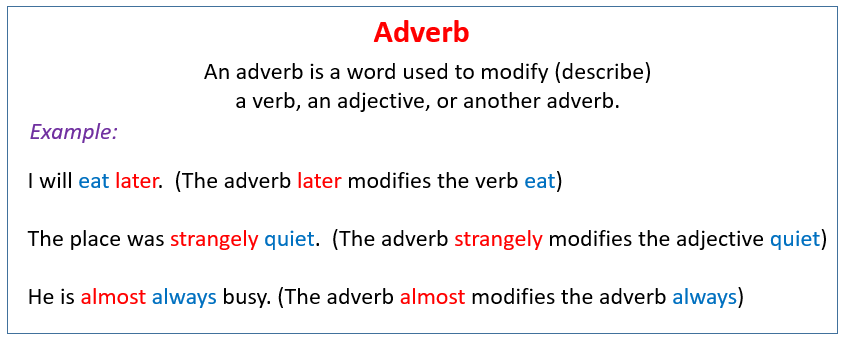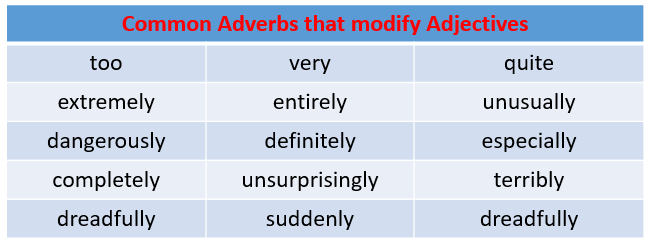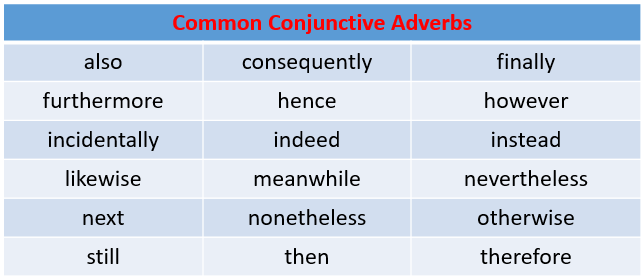Nouns and pronouns are modified by adjectives. Verbs and adjectives may have modifiers, too, and their modifiers are called adverbs.
An adverb is a word used to modify (describe) a verb, an adjective, or another adverb.
In this lesson, we will learn about
- adverbs that modify verbs
- adverbs that modify adjectives
- adverbs that modify other adverbs
- conjunctive adverbs
The following table gives some examples of adverbs that modify verbs, modify adjectives and modify other adverbs. Scroll down the page for more examples and explanations on how to use adverbs.

Adverbs Modifying Verbs
Sometimes an adverb modifies a verb. Adverbs modify verbs by answering one of these questions:
Where? When? How? How much?
Examples:
Where?
Stand here. (Verb – stand, Adverb – here)
I moved forward. (Verb – moved, Adverb – forward)
When?
I will eat later. (Verb – eat, Adverb – later)
Did you go immediately? (Verb – go, Adverb – immediately)
How?
I quickly moved. (Verb – moved, Adverb – quickly)
Did it move slowly? (Verb – move, Adverb – slowly)
How much?
I barely slept. (Verb – slept, Adverb – barely)
Did you go far? (Verb – go, Adverb – far)
Adverbs Modifying Adjectives
Sometimes an adverb modifies an adjective.
Examples:
She is an exceptionally good student. (exceptionally is the adverb that modifies the adjective good, which modifies the noun student.)
The house was strangely quiet. (strangely is the adverb that modifies the adjective quiet, which modifies the noun house.)
The following table gives some examples of adverbs that frequently modify adjectives.

Adverbs Modifying Other Adverbs
Sometimes an adverb modifies another adverb.
Examples:
She is almost always busy. (almost is the adverb that modifies the adverb always which modifies the verb busy)
They saw it rather recently. (rather is the adverb that modifies the adverb recently which modifies the verb saw)
Conjunctive Adverbs
We can use a conjunctive adverb to join two independent clauses together. Some of the most common conjunctive adverbs are:
The following table gives some examples of conjunctive adverbs.

Each clause linked by a conjunctive adverb remains independent and can stand alone. If the clauses are to be placed in a single sentence they must be separated by a semicolon.
Example:
She went to the store; however, she did not buy anything. (however is the conjunctive adverb that joins the two independent clauses she went to the store and she did not buy anything)
What is an Adverb?
Adverbs describe verbs, other adverbs and some adjectives. They never describe nouns.
Adjective or Adverb
An easy to understand tutorial explaining the most important rules of the formation and usage of adjectives and adverbs; in English
What are Adjectives and Adverbs?
Adjectives are used to describe nouns and pronouns, while adverbs are used to describe verbs and other adverbs. Discover when to use modifiers and what suffixes signify adverbs.
What is an Adverb Clause?
The following video explains how an adverb clause is used in a sentence.
Conjunctive Adverbs
A semicolon is used before conjunctive adverbs to join two independent clauses together. Discover why semicolons are used with conjunctive adverbs
How to use the conjunctive adverb “therefore” in a few sentences?
Try out our new and fun Fraction Concoction Game.
Add and subtract fractions to make exciting fraction concoctions following a recipe. There are four levels of difficulty: Easy, medium, hard and insane. Practice the basics of fraction addition and subtraction or challenge yourself with the insane level.

We welcome your feedback, comments and questions about this site or page. Please submit your feedback or enquiries via our Feedback page.